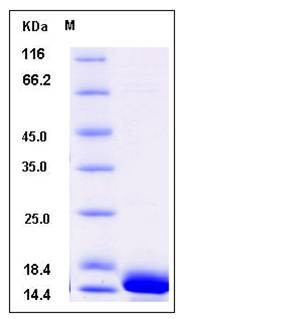Human CALML3 Protein (His Tag)
CLP
- 100ug (NPP3627) Please inquiry
| Catalog Number | P12480-H07E |
|---|---|
| Organism Species | Human |
| Host | E. coli |
| Synonyms | CLP |
| Molecular Weight | The recombinant human CALML3 consisting of 164 amino acids and has a calculated molecular mass of 18.7KDa. It migrates as an 16 kDa band in SDS-PAGE under reducing conditions. |
| predicted N | Met |
| SDS-PAGE |  |
| Purity | > 95 % as determined by SDS-PAGE |
| Protein Construction | A DNA sequence encoding the human CALML3 (P27482) (Met 1-Lys 149) was expressed, with a polyhistide tag at the N-terminus. |
| Bio-activity | |
| Research Area | Neuroscience |Neurotransmission |Calcium Signaling |Calmodulin Pathway |
| Formulation | Lyophilized from sterile PBS, pH 7.4 1. Normally 5 % - 8 % trehalose and mannitol are added as protectants before lyophilization. Specific concentrations are included in the hardcopy of COA. |
| Background | Calmodulin-like protein 3 (CALML3) is similar to that of authentic calmodulin and may actually compete with calmodulin by binding, with different affinity, to cellular substrates. Calmodulin-like protein 3 (CALML3) is a tumor-sensitive protein specifically expressed in normal epithelial cells but downregulated in tumorigenesis. Downregulation of the protein is an early event in breast cancer development. One of the most pressing questions raised by the discovery of CLP/CALML3 is that of its potential targets. Although it is 85% identical to human calmodulin, the distinct properties of CLP suggest that it has specific targets or targets that only partially overlap with those of calmodulin. Research has identified the unconventional myosin-10 (Myo10) as a specific target of CALML3. The discovery of Myo10 as a specific target of CALML3 is highly significant and suggests multiple lines of further research such as investigations of the Ca2+ regulation of Myo10 and the role of the loss of CLP in epithelial differentiation, adhesion, and cancer. Cells expressing CALML3 displayed a striking increase in the number and length of myosin-10-positive filopodia and showed increased mobility in a wound healing assay. |
| Reference |
